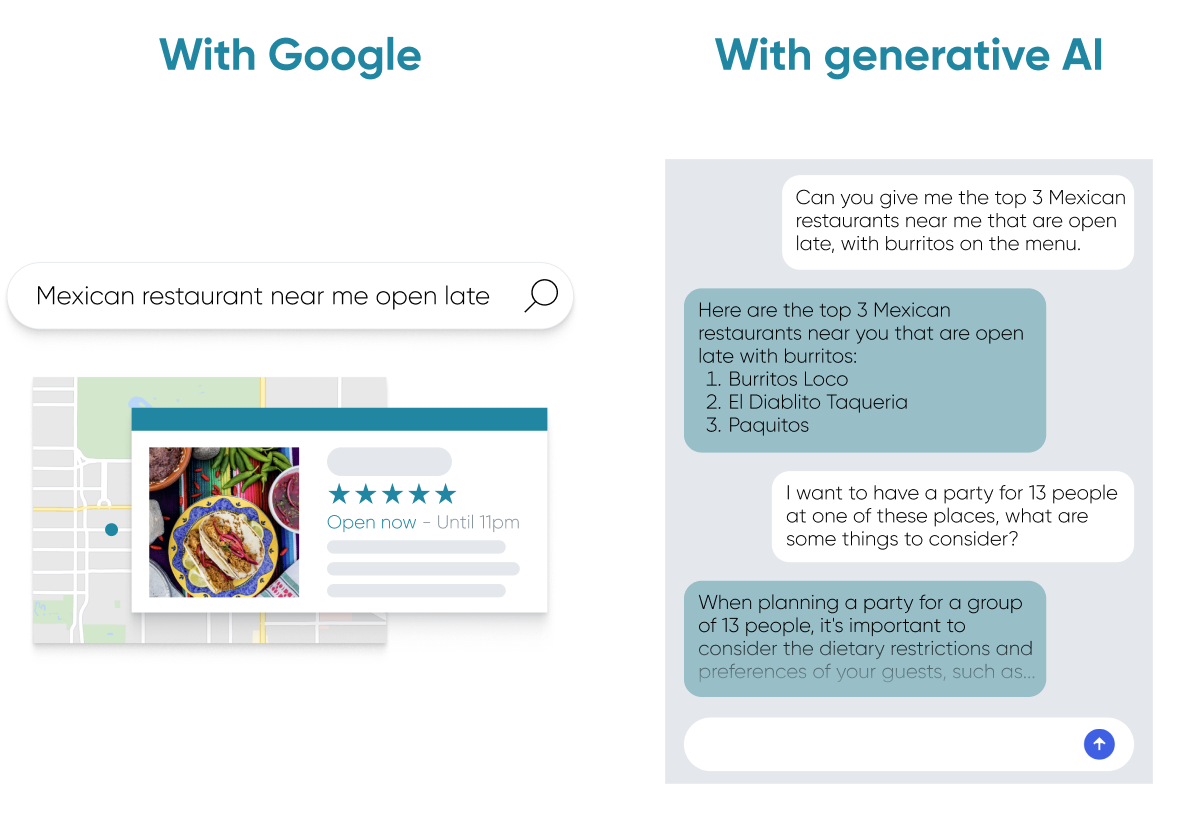The CMO’s Guide to Innovating with AI
AI has the potential to add $15.7T to global GDP by 2030.
Marketing use cases for AI are one of the most common areas where businesses are beginning to invest. But AI-enabled tools are multiplying at a moment when CMOs are tasked with creating value at scale in a challenging macro-environment. Knowing how to implement AI effectively – rather than simply knowing that you should — can be difficult.
In this guide, we'll break down three steps to AI innovation that every marketing leader should take today.


1. Build the right AI foundation at your organization — with your CMS

2. Leverage AI effectively in your organization — by focusing on the right use cases

3. Plan for the AI future
1. Build the right AI foundation at your organization — with your CMS

Right now, AI is a buzzword. But its value-add to digital experiences is fairly simple to understand: for years, the internet has given us access to "who, what, when, and where" information — and AI is simply adding the "how" and the "why."
Here's an example: Let's say someone makes a Google search for "Mexican restaurant near me open late." They'll see a mapped local pack result (the where) showing restaurants (the what) with hours of operation to indicate how late they're open (the when).
With generative AI — as you're likely aware from testing out ChatGPT — users can ask questions or prompt the model for even more information. Generative AI can contextually "converse" with a user back and forth to teach them how certain Mexican dishes are made, explain why a restaurant might be good for groups (based on summarizing thousands of reviews), and much more.

It's easy to see the power — and the relative ease — of AI. As a result, every digital experience will eventually be converted to or augmented by conversational AI. But as a leader looking to help your organization create meaningful — not simply novel — interactions with customers, you have to build the right foundation for AI. And that means having the right tech stack.
Conversational AI is only as valuable as the knowledge it possesses. As with all machine learning applications, there is concern around the "garbage-in, garbage-out" problem. Experiments with ChatGPT and other large language models (LLMs) show that the output you get from AI models reflects the data they were trained on. If you provide bad — or missing — data to a model, you won't get quality answers back.
Conversational AI can accurately answer business-related questions. But to do so, it needs to be able to draw on all of a business' facts and information in a centralized, organized place.
In other words, businesses need the right CMS — one that can then be combined with a conversational AI interface. Your CMS should be designed to feed answers to the AI systems that can actually "converse" with customers, while still allowing your business to maintain human control and oversight over exactly where each answer originated.
The first step to innovating with AI is to take control of your business information — and structure it in the right CMS.
Two main takeaways from this section:
-
You need to control your business information — and then AI will transform your knowledge and decide how and when to apply it.
-
When it comes to making the jump from your current marketing tech stack to one that leverages AI, you should look for a model-agnostic platform that allows you to then pick and choose the AI best for the use case. (More on use cases below.)
Click here to learn more.
2. Leverage AI effectively in your organization — by focusing on the right use cases

You'll hear a lot about "AI strategy" as a marketing buzzword today. The truth is that your AI strategy is really just your overall data strategy. (Remember: garbage in, garbage out. AI is only useful to your business if it is drawing on accurate inputs.)
So, once you've selected a model-agnostic platform that stores every interaction with your brand and is optimized for AI, you're ready for the second step: determining concrete use cases for AI in your organization.
There are certain types of tasks that are best suited for AI today, and you need to identify them. When thinking about where your business should leverage AI first, take a look at all of the workflows across your organization. Then, move to improve or automate tasks that are at least one of the following:
-
Data-driven: it's easy for AI systems to perform data-driven tasks based on the data you provide in your CMS
-
Repetitive: why waste human time on something rote and repetitive?
-
Making a prediction: AI is great at predicting based on set data/trends
-
Generating: AI is highly effective at generating content based on set inputs, like event descriptions, professional bios, etc.
Savvy marketers are already freeing up employee time and delivering more customer value with these types of set use cases. With that in mind, we created a full guide on the topic: click here to download The Four Essential AI Use Cases.
3. Plan for the AI future

As you read in section one, making the switch to a platform that is model-agnostic and allows you to layer AI on top is a smart bet for the present. But it also allows you to adapt for the AI of the future.
If you keep control over AI's access to your information in your CMS, you'll make sure that AI-generated responses to your users' questions are accurate, reliable, and compliant. That will be true whether you're working with AI models that exist today or AI systems of the future.
But building the right tech stack and identifying your business' optimal AI use cases aren't the only pieces of the puzzle. A great leader will also shape an organization's culture with regard to AI — and bring everyone along for the ride.
As we wrote recently, it's hard to envision a "knowledge work" job that isn't impacted by AI in some way over the next several years.
The range of automation or assistance may vary. Some might see 10% of their job altered, and others more like 50% - 80%, but a change is coming. It's a shift that leaders have every reason to be optimistic about, but setting up a successful future requires company preparation. Pause now to look at the people in your organization by job function and assess how AI might impact them.
Then it's time to be proactive about education: upskilling and reskilling workers. Then, you can start redistributing their time to valuable work as AI starts to play more of a role in rote activities. AI can be a net positive for both top-line business and individual workers, but that comes from responsible education and preparation.
Looking for a resource on these types of action items from the Marketing AI institute? Click here.
Conclusion
Marketing leaders play a critical role in driving AI innovation within their organizations. By making the right tech investments, deploying AI for the right use cases, and educating your organization from entry-level workers through the C-suite, you'll be set up for success in the AI future.
